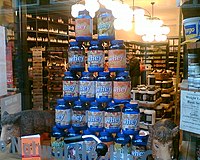乳清タンパク質

乳清タンパク質(にゅうせいタンパクしつ)またはホエイプロテイン(Whey protein)は、チーズ製造の副産物である乳清(ホエイ)から単離される球状タンパク質の混合物である。
乳清タンパク質はサプリメントとして流通し、代替医療としても用いられている[1]。乳清タンパク質は牛乳アレルギーの原因にもなることがあるが、牛乳の主要なアレルゲンはカゼインである[2][3]。
製造[編集]
乳清は、牛乳が凝固する際に残される成分であり、牛乳の全ての可溶成分を含む。ラクトースの5%水溶液にいくつかのミネラルとラクトアルブミンが加わったものである[4]。チーズを加工した後に取り除かれ、脂肪は除去した後、食用に加工される[4]。加工は、単純に乾燥させるか、脂肪やその他の非タンパク質成分が除いてタンパク質の含有量を高める[5]。例えば、膜濾過の後の噴霧乾燥によって、乳清からタンパク質を分離することができる[6]。
乳清は、加熱により変性させることができる。殺菌の際のように72℃以上の高い温度で加熱すると、乳清タンパク質が変性する。元々の乳清タンパク質は、レンネットや酸性化によって凝集することはないが、乳清タンパク質を変性すると、他のタンパク質と疎水相互作用し、ゲルを形成する[5]。熱により変性しても、乳清タンパク質のアレルゲンとしての性質は残る[7]。
組成[編集]
乳清タンパク質は、乳清から単離される球状タンパク質の混合物である。牛乳に含まれるタンパク質の20%が乳清タンパク質、80%がカゼインであるが[8]、ヒトの母乳では、60%が乳清タンパク質、40%がカゼインである[9]。乳清の固体成分の約10%がタンパク質であり、β-ラクトグロブリン(~65%)、α-ラクトアルブミン(~25%)、ウシ血清アルブミン(~8%)、免疫グロブリン等から構成される[10]。これらは、pHに関わらず、可溶である。
チーズ製造の際に動物のレンネットが使われている可能性が高いため、乳清タンパク質はラクト・ベジタリアンやユダヤ教徒が食べるのには適していない。しかし、非動物系の酵素を用いて、ラクト・ベジタリアン用に特別に作られた製品もある他、カシュルートやハラールの認定を受けた製品もある。
乳清タンパク質と筋肉[編集]
筋肉肥大における乳清タンパク質サプリメントの効果については、未だ議論がある。ある研究では、乳清タンパク質のサプリメントを摂取することで、しない場合と比べて男性の体の脂肪が少なくなり強度が増したという結果が出ており[11]、別の研究では乳清タンパク質を摂取するグループがカゼインを摂取するグループよりも強度の増加の効果が大きいのは、アミノ酸組成のせいであるという結果が得られた[12]。しかし、乳清タンパク質サプリメントの効果がほとんど、あるいは全くないことを示す研究結果も存在する。サプリメントを摂取する時期は、強度、パワー、体組成にほとんど影響を及ぼさないと考えられている[13]。老人を被験者とした研究では、運動の後にサプリメントを摂取することで、筋肉のタンパク質合成が改善したという結果が得られた[14]。
健康効果[編集]
乳清タンパク質をアミノ酸源として用い、心臓病、癌、糖尿病等のリスクを減らすことについては、2007時点で研究が実施されているとされる[15]。乳清には、タンパク質合成を促進する[16]分岐アミノ酸が豊富に含まれている[17]。特にロイシンは、タンパク質合成の転写を開始する上で重要な役割を果たしている[18]。乳清タンパク質サプリメント等でロイシンが大量に摂取されると、タンパク質合成が促進され、回復速度が上がったり、運動ストレスに適応できるようになったりする[19][20]。アトピー性皮膚炎のリスク排除の第一手段として乳児の完全母乳が推奨されており、実施しない場合には、システマティック・レビューによる18の研究はすべて、100%乳清タンパク質の分解乳を用いたほうが、牛乳たんぱく質を原料とする調整粉よりも、アトピー性皮膚炎とアトピー性疾患の発症リスクを低下させていた[21]。
乳清タンパク質は、グルタチオンの合成に関与するシステインを含む。しかし、このアミノ酸はグルタチオンの合成に必須ではなく、ある研究では食物中のシステインの量はグルタチオン合成にはほとんど影響を及ぼさないとされている[22]。しかし、別の研究では、大量の乳清タンパク質は細胞のグルタチオンのレベルを上げるという結果が示された[23]。グルタチオンは、身体をフリーラジカルや毒による損傷から守る抗酸化物質であり、動物実験では、牛乳に含まれるタンパク質が癌のリスクを減らすことが示されている[24]。
非常に強い発癌性物質であり、ミトコンドリアの損傷の主要な原因であるアフラトキシンは、乳清タンパク質やトチバニンジン属抽出物で阻害されることが示されている[25]。しかし、乳清タンパク質自体の中のアフラトキシンの量は、乳清タンパク質を作るのに用いられた無加工牛乳の量を反映していることが示されている[26]。
消化の問題[編集]
乳清タンパク質粉末の摂取後に、消化器官系の問題を生じる人もいる[27]。症状には、放屁、腫脹、腹痛、疲れ、倦怠感、頭痛、刺激痛等がある。考えられる原因の1つは、濃縮された乳清を摂取した後の乳糖不耐症である[28]。大腸の未消化タンパク質は細菌の餌となり、ガスや脂肪酸の生成に繋がる[29]。
脚注[編集]
- ^ Marshall, K (2004). “Therapeutic applications of whey protein”. Alternative Medicine Review 9 (2): 136-156. PMID 15253675.
- ^ Wal JM (November 2004). “Bovine milk allergenicity”. Ann. Allergy Asthma Immunol. 93 (5 Suppl 3): S2-11. doi:10.1016/S1081-1206(10)61726-7. PMID 15562868.
- ^ Burks W, Helm R, Stanley S, Bannon GA (June 2001). “Food allergens”. Curr Opin Allergy Clin Immunol 1 (3): 243-8. PMID 11964696.
- ^ a b "Whey." The Encyclopadia Britannica. 15th ed. 1994
- ^ a b Foegeding, EA; Davis, JP; Doucet, D; McGuffey, MK (2002). “Advances in modifying and understanding whey protein functionality”. Trends in Food Science & Technology 13 (5): 151-9. doi:10.1016/S0924-2244(02)00111-5.
- ^ Tunick MH (2008). “Whey Protein Production and Utilization.”. In Onwulata CI, Huth PJ (abstract). Whey processing, functionality and health benefits. Ames, Iowa: Blackwell Publishing; IFT Press. pp. 1-13
- ^ Lee YH (November 1992). “Food-processing approaches to altering allergenic potential of milk-based formula.”. J. Pediatr. 121 (5 Pt 2): S47–50. doi:10.1016/S0022-3476(05)81406-4. PMID 1447634.
- ^ Jay R. Hoffman and Michael J. Falvo (2004). “Protein - Which is best?”. Journal of Sports Science and Medicine (3): 118-130.
- ^ Luhovyy BL, Akhavan T, Anderson GH (2007). “Whey proteins in the regulation of food intake and satiety”. Journal of the American College of Nutrition 26 (6): 704S-712S. PMID 18187437. オリジナルの2011年3月26日時点におけるアーカイブ。.
- ^ Haug A, Hostmark AT, Harstad OM, A; Hostmark, AT; Harstad, OM (25 September 2007). “Bovine milk in human nutrition - a review”. Lipids Health Dis 6: 25. doi:10.1186/1476-511X-6-25. PMC 2039733. PMID 17894873.
- ^ Burke, Darren G.. “The Effect of Whey Protein Supplementation With and Without Creatine Monohydrate Combined With Resistance Training on Lean Tissue Mass and Muscle Strength”. International Journal of Sport Nutrition and Exercise Metabolism. Human Kinetics Publishers, Inc.. 2012年4月4日閲覧。
- ^ Cribb, Paul J.; Andrew D. Williams, Michael F. Carey, Alan Hayes. “The Effect of Whey Isolate and Resistance Training on Strength, Body Composition, and Plasma Glutamine”. International Journal of Sport Nutrition and Exercise Metabolism. Human Kinetics, Inc. 2012年4月4日閲覧。
- ^ Hoffman, JR; Ratamess, NA; Tranchina, CP; Rashti, SL; Kang, J; Faigenbaum, AD (2009). “Effect of protein-supplement timing on strength, power, and body-composition changes in resistance-trained men”. International journal of sport nutrition and exercise metabolism 19 (2): 172-85. PMID 19478342.
- ^ Yang, Y; Breen, L; Burd, NA; Hector, AJ; Churchward-Venne, TA; Josse, AR; Tarnopolsky, MA; Phillips, SM (2012 Feb 7). “Resistance exercise enhances myofibrillar protein synthesis with graded intakes of whey protein in older men.”. The British journal of nutrition: 1-9. PMID 22313809.
- ^ Krissansen GW (December 2007). “Emerging health properties of whey proteins and their clinical implications”. J Am Coll Nutr 26 (6): 713S-23S. PMID 18187438.
- ^ Kimball Scott; Jefferson, LS (2006). “Signaling Pathways and Molecular Mechanisms through which Branched-Chain Amino Acids Mediate Translational Control of Protein Synthesis”. The Journal of Nutrition 136 (1): 227S-31S. PMID 16365087.
- ^ Rieu I, Balage M, Sornet C, et al. (April 2007). “Increased availability of leucine with leucine-rich whey proteins improves postprandial muscle protein synthesis in aging rats”. Nutrition 23 (4): 323-31. doi:10.1016/j.nut.2006.12.013. PMID 17367997.
- ^ Fujita, Dreyer, Drummon, Glynn, cadenas, Et Al. (2007). “Nutrient signalling in the regulation of human muscle protein synthesis”. The Journal of physiology 582 (Pt 2): 813-23. doi:10.1113/jphysiol.2007.134593. PMC 2075348. PMID 17478528.
- ^ Ha E, Zemel MB (May 2003). “Functional properties of whey, whey components, and essential amino acids: mechanisms underlying health benefits for active people (review)”. J. Nutr. Biochem. 14 (5): 251-8. doi:10.1016/S0955-2863(03)00030-5. PMID 12832028.
- ^ Layman D.K., Evans E., Baum J.I., Seyler J., Erickson D.J., Boileau R.A. (2005). “Dietary protein and exercise have additive effects on body composition during weight loss in adult women”. J. Nutr 135: 1903-1910.
- ^ Alexander DD, Schmitt DF, Tran NL, Barraj LM, Cushing CA (2010). “Partially hydrolyzed 100% whey protein infant formula and atopic dermatitis risk reduction: a systematic review of the literature”. Nutrition Reviews 68 (4): 232–45. doi:10.1111/j.1753-4887.2010.00281.x. PMID 20416019.
- ^ Courtney-Martin G, Rafii M, Wykes LJ, Ball RO, Pencharz PB (November 2008). “Methionine-adequate cysteine-free diet does not limit erythrocyte glutathione synthesis in young healthy adult men”. J. Nutr. 138 (11): 2172-8. doi:10.3945/jn.108.093302. PMID 18936215.
- ^ Zavorsky, Kubow, Grey, Riverin, Lands (2007). “An open-label dose-response study of lymphocyte glutathione levels in healthy men and women receiving pressurized whey protein isolate supplements”. International Journal of Food Sciences and Nutrition 58 (6): 429-36. doi:10.1080/09637480701253581. PMID 17710587.
- ^ P.W. Parodi. “A Role for Milk Proteins and their Peptides in Cancer Prevention”. Current Pharmaceutical Design 13 (8): 813-828. ISSN 1381-6128. オリジナルの2009年9月24日時点におけるアーカイブ。.
- ^ http://www.ncbi.nlm.nih.gov/pubmed/21536149
- ^ http://www.ncbi.nlm.nih.gov/pubmed/16107394
- ^ “Digestive Problems Commonly Associated With Whey Protein”. Livestrong.Com. 2013年2月7日閲覧。
- ^ Does 100% whey protein make you have bad gas?, Livestrong.com
- ^ Le Leu, R. K.; Brown, I. L.; Hu, Y.; Morita, T.; Esterman, A.; Young, G. P. (2006). “Effect of dietary resistant starch and protein on colonic fermentation and intestinal tumourigenesis in rats”. Carcinogenesis 28 (2): 240-5. doi:10.1093/carcin/bgl245. PMID 17166881.
外部リンク[編集]
- Whey protein resources, National Dairy Council
- Whey Protein Healthnotes[リンク切れ], University of California, San Diego
- Whey Protein Facts, Whey Protein Institute
- What does science say about whey protein and muscle building?, European Food Safety Authority on whey protein claims
